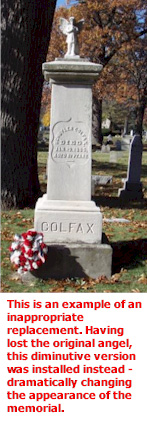|
Selecting the Right Firm to
Do Repairs
This page provides guidance on the ethics you should expect
from a firm providing treatments -- or repairs -- to your cemetery monuments and
fences.
First, the firm should subscribe to the
Code of Ethics and Standards of Practice of the American Institute for
Conservation of Historic and Artistic Works. You can learn more about
these by linking to
AIC.
The Standards of Practice provide guidelines for professional conduct,
examination and scientific investigation, preventative conservation, and
treatments. They ensure that the integrity of the original fabric is respected,
that in so far as possible only reversible treatments are undertaken, and that
the treatments are appropriate.
Chicora Foundation is a member of AIC and subscribes to the Code of Ethics and Standards of Practice.
Second, the firm should be aware of --
and willing to comply with -- the Secretary of the Interior's Standards.
These standards, while often thought to be associated with structures, are
actually developed for a wide range of projects, including landscapes and other
various conservation treatments. They can be applied to a wide range of projects
-- including cemetery repairs and treatments. These guidelines -- like the AIC
Standards of Practice -- focus on ensuring that the proposed work is compatible
with the original material, that the work is carefully documented, that the
original fabric is preserved, and that all treatments are the gentlest possible.
For more information visit the National Park Service's Standards for Preservation.
Chicora Foundation recognizes the fundamental importance of
these standards and works to ensure that they are complied with on all
projects.
Third, the firm should be aware of what
is called
The Venice
Charter -- a foundation for world-wide conservation
ethics. It outlines many of the important issues involved in the
long-term preservation of monuments -- whether buildings or tombstones.
Chicora Foundation is a supporter of this document and
encourages others in preservation to become aware of it critical
recommendations.
Finally, ensure that those hired for
their trade skills understand fundamental preservation practices. For
example, does your mason understand the use of lime based mortars? Does he or
she understand the damage that hard Portland cement mortars can do to soft,
porous bricks? Does the mason exhibit good practices, such as carefully
measuring and mixing mortars? Even a mason, if he or she is doing preservation
quality work, should be familiar with the Secretary of the Interior's Standards.
Remember, just because someone has been doing something for 50
years doesn't mean they're been doing it correctly all that time. The only
way you can protect your cemetery is to hire a preservation consultant to
develop specifications and oversee the work. Chicora is happy to work with you
to make certain that the work done by the trades is professional and
appropriate.
------------------------------------------------------------
Let's look at one example and see how conservation ethics
may affect our decision. A pedestal tomb has lost its vase. The client wants to
replace this vase, "so the stone will look like the others in the cemetery." Not
having a photograph or any fragments from the original, the client wants to
"just make one that looks like the others in the cemetery." What's your
response? Here's ours:
 We do not encourage -- or participate in -- the replacement of
historic fabrics when there is no documentary information on which to base the
replacement and the replacement is entirely aesthetic. We explain that to
recreate this vase would result in something that is no longer "real." It
promotes a "Disney" version of history -- something that appears pretty, but
which has no solid foundation. Such recreations can't be consistent with the
intent of the original artisan or the family that had the monument erected.
Instead, allow the monument to stand as it as, rich in the patina of age and
reflecting some of the past's scars. Emphasize the beauty of what is present,
rather than detracting from it through the addition of some made-up, modern
item. We do not encourage -- or participate in -- the replacement of
historic fabrics when there is no documentary information on which to base the
replacement and the replacement is entirely aesthetic. We explain that to
recreate this vase would result in something that is no longer "real." It
promotes a "Disney" version of history -- something that appears pretty, but
which has no solid foundation. Such recreations can't be consistent with the
intent of the original artisan or the family that had the monument erected.
Instead, allow the monument to stand as it as, rich in the patina of age and
reflecting some of the past's scars. Emphasize the beauty of what is present,
rather than detracting from it through the addition of some made-up, modern
item.
We also recognize, however, that there are degrees of
replacement. Let's say that we aren't talking about a vase, but rather a side
panel for a cradle grave. Without this panel the monument is compromised not only
aesthetically, but also structurally. In addition, we have one side panel and
know the material, its length, height, and thickness. We have information on how
it was originally joined.
In this case, it might be appropriate to have a new side
panel cut, especially if it is a simple, unadorned piece. This new piece could
be signed and dated by the stonecutter, so its modern origin would be well
documented. And its addition to the cradle grave would help ensure the stability
and preservation of the entire monument.
While many ethical issues in cemetery preservation aren't this
simple, we hope this gives you an idea of the issues that need to be considered
and points out that often simple solutions to complex problems cause tremendous
damage to what we are attempting to preserve and protect.
|